最新人教版高中英语-全英文说课稿-music
- 格式:doc
- 大小:43.00 KB
- 文档页数:8
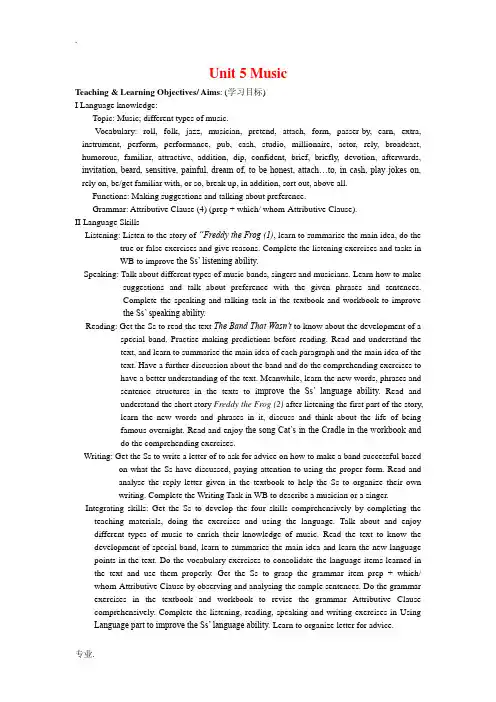
Unit 5 MusicTeaching & Learning Objectives/ Aims: (学习目标)I Language knowledge:Topic: Music; different types of music.V ocabulary: roll, folk, jazz, musician, pretend, attach, form, passer-by, earn, extra, instrument, perform, performance, pub, cash, studio, millionaire, actor, rely, broadcast, humorous, familiar, attractive, addition, dip, confident, brief, briefly, devotion, afterwards, invitation, beard, sensitive, painful, dream of, to be honest, attach…to, in cash, play jokes on, rely on, be/get familiar with, or so, break up, in addition, sort out, above all.Functions: Making suggestions and talking about preference.Grammar: Attributive Clause (4) (prep + which/ whom-Attributive Clause).II Language SkillsListening: Listen to the story of “Freddy the Frog (1), learn to summarise the main idea, do the true or false exercises and give reasons. Complete the listening exercises and tasks inWB to improve the Ss’ listening ability.Speaking: Talk about different types of music bands, singers and musicians. Learn how to make suggestions and talk about preference with the given phrases and sentences.Complete the speaking and talking task in the textbook and workbook to improvethe Ss’ speaking ability.Reading: Get the Ss to read the text The Band That Wasn’t to know about the development of a special band. Practise making predictions before reading. Read and understand thetext, and learn to summarise the main idea of each paragraph and the main idea of thetext. Have a further discussion about the band and do the comprehending exercises tohave a better understanding of the text. Meanwhile, learn the new words, phrases andsentence structures in the texts to i mprove the Ss’ language ability. Read andunderstand the short story Freddy the Frog (2) after listening the first part of the story,learn the new words and phrases in it, discuss and think about the life of beingfamous overnight. Read and enjoy the song Cat’s in the Cradle in the workbook anddo the comprehending exercises.Writing: Get the Ss to write a letter of to ask for advice on how to make a band successful based on what the Ss have discussed, paying attention to using the proper form. Read andanalyse the reply letter given in the textbook to help the Ss to organize their ownwriting. Complete the Writing Task in WB to describe a musician or a singer.Integrating skills: Get the Ss to develop the four skills comprehensively by completing the teaching materials, doing the exercises and using the language. Talk about and enjoy different types of music to enrich their knowledge of music. Read the text to know the development of special band, learn to summaries the main idea and learn the new language points in the text. Do the vocabulary exercises to consolidate the language items learned in the text and use them properly. Get the Ss to grasp the grammar item prep + which/ whom-Attributive Clause by observing and analysing the sample sentences. Do the grammar exercises in the textbook and workbook to revise the grammar Attributive Clause comprehensively. Complete the listening, reading, speaking and writing exercises in Using Language part to improve the Ss’ language ability. Learn to organize letter for advice.III Emotion & Attitudes: Get the Ss to know different types of music and learn to enjoy different types of music. Have the right attitudes towards music and the life of being famous overnight.IV Learning Strategies: Learn to judge the meaning of a word according to the context. Learn to classify and conclude the vocabulary into categories. Learn to conclude the main idea according to the given information. Learn to conclude the grammar rules by observing the sample sentences.V Cultural consciousness: learn to appreciate and accept different kinds of music.Main Points: (重点) new words, language points and language skills listed above, the reading comprehension of the text and main idea summary, the grammar items, thepractical writing—a formal letter for advice.Difficult points: (难点) new words and new language points, listening, the reading comprehension of the text, the persuasive writing—a formal letter of advice. Teaching Mode: (教学模式) Task-based TeachingTime: (课时)Period (45min×8 )Teaching Aids: (教具)Multi-media teaching systemPeriod 1Date: (日期)______月______日Class: Class 8 Grade 1 高一_____班Teaching & learning contents: (教学内容) Warming up and Listening & Talking in WB. Teaching & learning goals: (教学目标)1. Introduce different types of music, identify different types of music and talk about their feelings to different types of music and their preferences to music.2. Practise listening to the short text about Mozart and do the listening exercises in WB. .3. Talk about “Mozart effect〞with the give expressions on P69 in the workbook.Main points: (重点) Warming up and talking.Difficult points: (难点) Different types of music and the identification of different music.Class type: (课型)Warming up, listening and talkingTeaching & learning procedures: (教学步骤)Step 1 Lead-inUse the questions “D o you like music? What kind of music do you like best? Who is your favourite singer/musician/ or band? Are you good at singing and enjoying music?〞to lead in the topic music, and then introduce the main contents of this unit.Step 2 Warming upTask 1: Name different types of music that you know about in pairs without looking at the textbook, and then give a report.Possible answers: classical music, folk music, rock and roll, jazz, orchestra, choral, country music, rap(hi-pop), pop, blues, etc.Task 2 Look at the pictures in the warming up and give a brief introduction to the different types of music with the help of PPT and learn the new words.Introduction to different types of music:Classical music---Music that people consider to be serious and has been popular for a long time.Folk music---It has been passed down from one generation to another. At first it was never written down. People learnt it from their parents. Most of the songs are about country life, the seasons, animals, and about love and sa dness in people’s life.Rock ’n’ Roll ---A style of music that was popular in the 1950s, and has a strong loud beat. Jazz ---It was born in the US around 1890. It was sung by black people and its roots in Africa. Orchestra---A large group of people playing all kinds of musical instruments among together. Country music is popular music in the style of music from the southern and western US.Rap ---A popular music in the style of music form the southern and western US.Choral---A traditional Christmas song, which is often sung in the church on Christmas Day. New words: classical, folk, roll (vt. & vi), rock and roll, jazz, orchestra, choral, rapNotes:1. roll vt.滚动, 滚转, n.摇摆, (一)卷, 卷形物, 摇晃, 面包圈2. folk n. 人们(复数形式可加s, 也可不加, 表示家里人, 父母(常加s) adj. 民间的eg. They are the best folks on the earth. 他们是天底下最好的人。
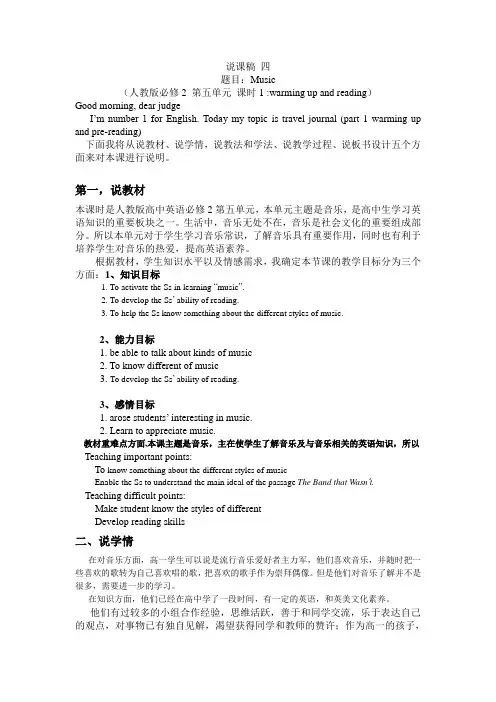
说课稿四题目:Music(人教版必修2 第五单元课时1 :warming up and reading)Good morning, dear judgeI’m number 1 for English. Today my topic is travel journal (part 1 warming up and pre-reading)下面我将从说教材、说学情,说教法和学法、说教学过程、说板书设计五个方面来对本课进行说明。
第一,说教材本课时是人教版高中英语必修2第五单元,本单元主题是音乐,是高中生学习英语知识的重要板块之一。
生活中,音乐无处不在,音乐是社会文化的重要组成部分。
所以本单元对于学生学习音乐常识,了解音乐具有重要作用,同时也有利于培养学生对音乐的热爱,提高英语素养。
根据教材,学生知识水平以及情感需求,我确定本节课的教学目标分为三个方面:1、知识目标1. To activate the Ss in learning “music”.2. To develop the Ss’ ability of reading.3. To help the Ss know something about the different styles of music.2、能力目标1. be able to talk about kinds of music2. To know different of music3. To develop the Ss’ ability of reading.3、感情目标1. arose students’ interesting in music.2. Learn to appreciate music.教材重难点方面,本课主题是音乐,主在使学生了解音乐及与音乐相关的英语知识,所以Teaching important points:To know something about the different styles of musicEnable the Ss to understand the main ideal of the passage The Band that Wasn’t.Teaching difficult points:Make student know the styles of differentDevelop reading skills二、说学情在对音乐方面,高一学生可以说是流行音乐爱好者主力军,他们喜欢音乐,并随时把一些喜欢的歌转为自己喜欢唱的歌,把喜欢的歌手作为崇拜偶像。
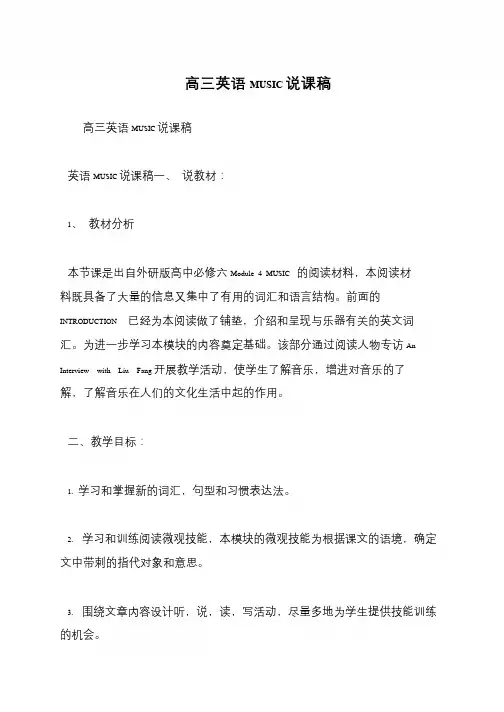
高三英语MUSIC 说课稿
高三英语MUSIC 说课稿
英语MUSIC 说课稿一、说教材:
1、教材分析
本节课是出自外研版高中必修六Module 4 MUSIC 的阅读材料,本阅读材料既具备了大量的信息又集中了有用的词汇和语言结构。
前面的INTRODUCTION 已经为本阅读做了铺垫,介绍和呈现与乐器有关的英文词汇。
为进一步学习本模块的内容奠定基础。
该部分通过阅读人物专访An Interview with Liu Fang 开展教学活动,使学生了解音乐,增进对音乐的了解,了解音乐在人们的文化生活中起的作用。
二、教学目标:
1. 学习和掌握新的词汇,句型和习惯表达法。
2. 学习和训练阅读微观技能,本模块的微观技能为根据课文的语境,确定文中带刺的指代对象和意思。
3. 围绕文章内容设计听,说,读,写活动,尽量多地为学生提供技能训练的机会。
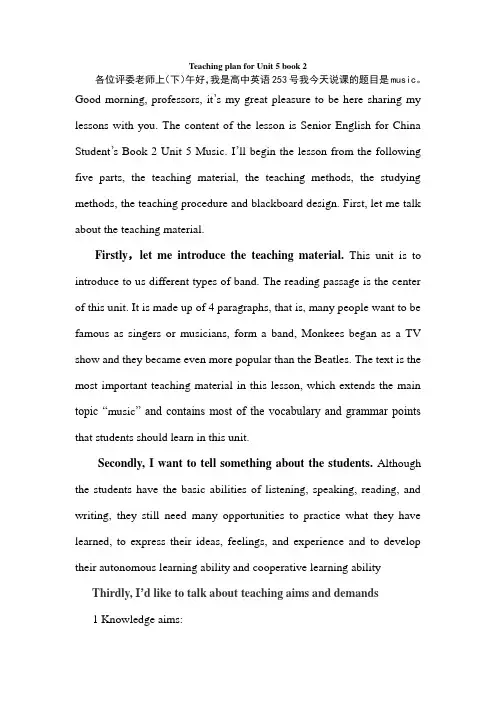
Teaching plan for Unit 5 book 2各位评委老师上(下)午好,我是高中英语253号我今天说课的题目是music。
Good morning, professors, it’s my great pleasure to be here sharing my lessons with you. The content of the lesson is Senior English for China Student’s Book 2 Unit 5 Music. I’ll begin the lesson from the following five parts, the teaching material, the teaching methods, the studying methods, the teaching procedure and blackboard design. First, let me talk about the teaching material.Firstly,let me introduce the teaching material.This unit is to introduce to us different types of band. The reading passage is the center of this unit. It is made up of 4 paragraphs, that is, many people want to be famous as singers or musicians, form a band, Monkees began as a TV show and they became even more popular than the Beatles. The text is the most important teaching material in this lesson, which extends the main topic “music” and contains most of the vocabulary and grammar points that students should learn in this unit.Secondly, I want to tell something about the students. Although the students have the basic abilities of listening, speaking, reading, and writing, they still need many opportunities to practice what they have learned, to express their ideas, feelings, and experience and to develop their autonomous learning ability and cooperative learning ability Thirdly, I’d like to talk about teaching aims and demands1 Knowledge aims:(1)to help students to understand and master the words, phrases and sentence patterns.(2)to know some basic information about music2 Ability aims:(1) To improve the students’ organizing and using skills of English asthe second language(2) To understand the main idea, to scan for the needed informationand to grasp the details3 Emotional aims:(1) Help students understand different type of music and how to forma band(2) Develop students’ sense of cooperative learningFourthly, teaching key points is1. To help the students get a general idea of the whole passage, and some detailed information and language points as well.2. To understand how Monkees formed, developed and succeed. Teaching difficult points is1. The students use their own words to express their own ideas.2. the prep+ whom/which attribute clauseAccording to the analysis above, I’ll try to use the following theories to make students the real master of the class while the teacher myself the director.a. Communicative Language TeachingLanguage is used for communication. It’s learner-centered and emphasizes communication and real-life situations.b. Task-based Language TeachingA task resembles activities which our students or other people carry out in everyday life, Learners should be given opportunities to reflect on what they have learned and how well they are doing.c. Computer Assisted Language TeachingLanguage learning needs a context, which can help the learners to understand the language and then can product comprehensible output, so computer has the advantages to make the materials attractive.Part 3 Learning MethodsTask-based, self-dependent and cooperative learningPart 4 Teaching ProcedureStep One Lead-in“Interest is the best teacher.” Therefore, at the very beginning of the class, I should spark the students’ mind to focus on the cent re topic “the band”. I’ll play some different type of music to attract their attention and then bring some questions.Question:What kind of music they like?Which band they know best?The answers must relate to band. After this, the students will be eager to know something about band and this is the very time to naturally lead the class into Step 2Step 2 Reading for information: skimming and scanningIn this step, I use Task-based Language Teaching method, which can give students a clear and specific purpose while skimming and scanning the context.Task 1 General ideaThe students will be asked to just glance at the title and the pictures of the passage, and then guess what they will read in the text. And they’ll be divided into groups of four to have a discussion.The purpose is to inspire the students to read actively, not passively. In addition, the task is to develop the students’ reading skill by making prediction and to encourage the students to express their thoughts in English and cooperate with each other.Task 2 Main idea of each paragraphCooperative learning can raise the students’ interest and create an atmosphere of achievement. Based on this theory, I divide the whole class into 4 groups to skim the whole text and get the main idea of each paragraph.Step 3 Reading for comprehensionThe purpose of reading is to get the correct and useful information. Students should not only have a high speed of reading but also have a correct understanding of details. Therefore the following practices on Page 35 can help check the situation.Step 4 Solving difficult language problems through readingIt’s important for language learners to learn important rules of grammar and use these rules to solve problems in reality. In the previous process of reading, the students must come across some difficult language obstacles, so it’s necessary for us to discuss and explain. This period of time belongs to students. They can ask any questions they come across in the process of learning. I’ll explain the questions and difficulties. The purpose of this is improving the students “questioning spirit” and dealing with the difficulties.Step 5 ConsolidationLanguage is learnt by communicating. It is my job to create an atmosphere for students to use the language. Here I design 2 activities1 Reading for comprehensionI’ll ask 4 students to read each paragraph, and then do the exercise following the text. I think it’s a good way to review what they have learned.2 DiscussionDuring making discussion, the students will deepen their understanding of the main idea of the passage.a. Why Monkees can be successful? Give reasons.b. What’s the most important thing for a successful band? Why? Step 6 HomeworkAsk the students to write down sth about their favorite singers, band or music and list the reasons.The assignment enables the students to search various information resources, which can widen their view and continue to inspire their enthusiasm of learning.Part 5 Blackboard designUnit 4 MusicPassage The Band That Wasn’tTopic Sentences:1. Many people want to be famous as singers or musician2. Form a band3. Began as a TV4. They became even more famous than the BeatlesDiscussion:a. Why Monkees can be successful? Give reasons.b. What’s the most important thing for a successful band? Why?In my opinion, the blackboard design can reflect the teacher’s ability of mastering the text and leading the students to master the text easily.In this text, the design is not easy to write. I write the topic sentences on the blackboard, in order to tell the students that this is of the importance in this class. I want to make the design inductive, instructive and artistic.。

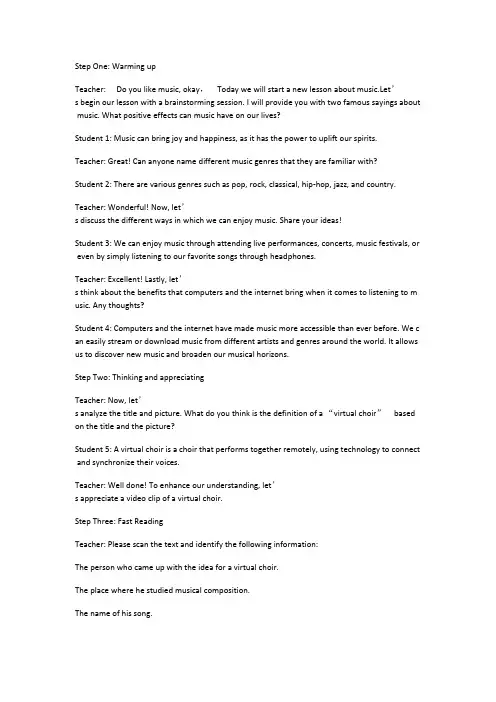
Step One: Warming upTeacher: Do you like music, okay,Today we will start a new lesson about music.Let’s begin our lesson with a brainstorming session. I will provide you with two famous sayings about music. What positive effects can music have on our lives?Student 1: Music can bring joy and happiness, as it has the power to uplift our spirits.Teacher: Great! Can anyone name different music genres that they are familiar with?Student 2: There are various genres such as pop, rock, classical, hip-hop, jazz, and country.Teacher: Wonderful! Now, let’s discuss the different ways in which we can enjoy music. Share your ideas!Student 3: We can enjoy music through attending live performances, concerts, music festivals, or even by simply listening to our favorite songs through headphones.Teacher: Excellent! Lastly, let’s think about the benefits that computers and the internet bring when it comes to listening to m usic. Any thoughts?Student 4: Computers and the internet have made music more accessible than ever before. We c an easily stream or download music from different artists and genres around the world. It allows us to discover new music and broaden our musical horizons.Step Two: Thinking and appreciatingTeacher: Now, let’s analyze the title and picture. What do you think is the definition of a “virtual choir”based on the title and the picture?Student 5: A virtual choir is a choir that performs together remotely, using technology to connect and synchronize their voices.Teacher: Well done! To enhance our understanding, let’s appreciate a video clip of a virtual choir.Step Three: Fast ReadingTeacher: Please scan the text and identify the following information:The person who came up with the idea for a virtual choir.The place where he studied musical composition.The name of his song.Student 6: Eric Whitacre came up with the idea for a virtual choir. He studied musical compositio n at the Juilliard School. His song is called “Lux Aurumque.”Teacher: Excellent job! You have successfully grasped the key information from the text.Step Four: Reading & thinkingTeacher: Now, let’s delve deeper into the topic by completing a mind map based on the first paragraph.Students work on completing the mind map, exploring the concept and significance of a virtual c hoir.Teacher: Well done! Now, let’s engage in a discussion to analyze the advantages and disadvantages of being a member of a virt ual choir.Students discuss in groups and share their opinions, considering aspects such as flexibility, global collaboration, and potential challenges faced in a virtual setting.Teacher: Great discussions! For your homework, I would like you to reflect on whether a virtual c hoir truly brings people together and explain why or why not.Step Five: Careful Reading and ExerciseTeacher: Carefully read the text and ponder the reasons behind Eric’s successful creation of a virtual choir. Also, pay attention to the transition sentences that connec t different parts of the text.(Students read and contemplate independently, considering factors such as innovative use of t echnology, the ability to reach a wider audience, and the impact on artistic collaboration.)Step five: post-readingTeacher: Now, let’s discuss the reasons behind Eric’s success in creating a virtual choir. Share your thoughts and opinions, drawing from the text and your own insights. Who would like to start?Student 1: I believe Eric’s success can be attributed to his strong leadership and clear vision. He was able to inspire and g uide the participating singers towards a common goal, ensuring everyone understood their role i n the virtual choir.Teacher: That’s an excellent point! Eric’s leadership skills were instrumental in bringing together a diverse group of singers and fostering a sense of unity. Clear communication and guidance are essential in any collaborative project, es pecially in a virtual setting.Student 2: Another factor contributing to Eric’s success is his innovative use of technology. By utilizing video conferencing platforms and editin g software, he was able to connect and synchronize the voices of the singers, creating a seamless virtual choir experience.Teacher: Absolutely! Eric’s ability to embrace technology and leverage its potential played a crucial role in overcoming the physical barriers and bringing together singers from different locations. This showcases the powe r of technology in facilitating collaboration and artistic expression.Student 3: I think one of the reasons behind Eric’s success is the dedication and commitment of the participating singers. Despite the challenges o f recording their individual parts separately, they put in the effort to ensure the quality of their p erformances.Teacher: Well said! The dedication and commitment of the participating singers were indeed vita l in creating a cohesive virtual choir. Their individual efforts combined to produce a harmonious p erformance, showcasing the importance of individual contributions within a collective endeavor. Step six: summary and homeworkSummary: Let the students to summarize what they have learned today then the teacher sublima te it like this:Let the music heal the world! Music has the remarkable power to ignite passion and evoke emotions that transcend boundaries. It is a universal language that speaks to the core of o ur being, connecting people from different cultures, backgrounds, and experiences. In times of h ardship and despair, music has the ability to uplift our spirits, provide solace, and bring a sense of unity.When we immerse ourselves in the melodies and rhythms of music, we embark on a transformat ive journey. It has the potential to heal wounds, mend broken hearts, and bring forth feelings of j oy and happiness. Music has the ability to transcend language barriers, allowing us to express ou r deepest emotions and thoughts without the need for words.Moreover, music has the power to bridge gaps and foster understanding among diverse commun ities. It serves as a catalyst for dialogue, encouraging individuals to embrace cultural diversity and appreciate the richness of different musical traditions. Through music, we can celebrate our shar ed humanity and promote peace and harmony in a world that often feels divided.As we navigate the challenges of the world, let us turn to music as a source of inspiration and ho pe. Let us use our musical talents and passions to create positive change and make a difference. Whether it’s through performing, composing, or simply listening, we can all contribute to the healing power of music.So, let us come together and let the music heal the world. Let us spread love, joy, and unity throu gh the universal language of music. With each note, rhythm, and melody, we can create a harmo nious symphony that transcends borders, unites hearts, and inspires us to build a better world.Homework:For that we are still faced with a serious epidemic situation around the world, please make a poster to call for music lovers from all over the world to take part in a virtual choir of an i nspirational song.。
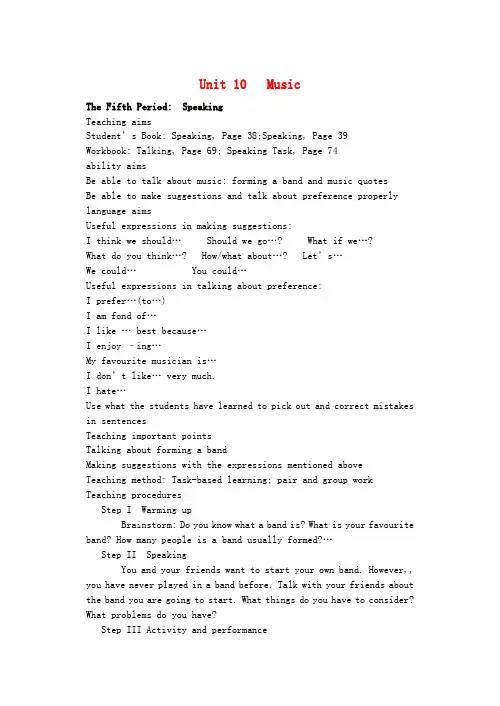
Unit 10 MusicThe Fifth Period: SpeakingTeaching aimsStudent’s Book: Speaking, Page 38;Speaking, Page 39Workbook: Talking, Page 69; Speaking Task, Page 74ability aimsBe able to talk about music: forming a band and music quotesBe able to make suggestions and talk about preference properly language aimsUseful expressions in making suggestions:I think we should… Should we go…? What if we…?What do you think…? How/what about…? Let’s…We could… You could…Useful expressions in talking about preference:I prefer…(to…)I am fond of…I like … best because…I enjoy –ing…My favourite musician is…I don’t like… very much.I hate…Use what the students have learned to pick out and correct mistakes in sentencesTeaching important pointsTalking about forming a bandMaking suggestions with the expressions mentioned aboveTeaching method: Task-based learning; pair and group work Teaching proceduresStep I Warming upBrainstorm: Do you know what a band is? What is your favourite b and? How many people is a band usually formed?…Step II SpeakingYou and your friends want to start your own band. However,, you have never played in a band before. Talk with your friends about the band you are going to start. What things do you have to consider? What problems do you have?Step III Activity and performanceForm your own band in groups of four. Decide who will play what instrument and who will sing. Choose a name of your band and an English song and then try perform it to the class.Step IV Talking and writingTalk about the music sayings in groups and tell what they mean and what do you think of them. Then choose the one you like best and write down what it means to you and what do you think of music. Exchange your work with your partner(s).Step V Workbook: TalkingMake suggestions by talking about going to a concert this Friday evening. The students are encouraged to use the expressions on the screen.Step VI Workbook: Speaking TaskIn pairs the students talk about preference about different kinds of music and musicians. The students should be able to use the expressions of preference in their talking.Homework:Use the internet to search for more music quotes.。
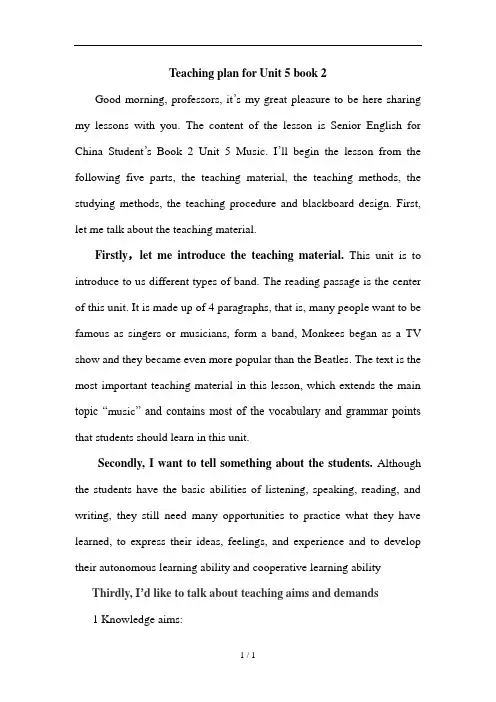
Teaching plan for Unit 5 book 2Good morning, professors, it’s my great pleasure to be here sharing my lessons with you. The content of the lesson is Senior English for China Student’s Book 2 Unit 5 Music. I’ll begin the lesson from the following five parts, the teaching material, the teaching methods, the studying methods, the teaching procedure and blackboard design. First, let me talk about the teaching material.Firstly,let me introduce the teaching material.This unit is to introduce to us different types of band. The reading passage is the center of this unit. It is made up of 4 paragraphs, that is, many people want to be famous as singers or musicians, form a band, Monkees began as a TV show and they became even more popular than the Beatles. The text is the most important teaching material in this lesson, which extends the main topic “music” and contains most of the vocabulary and grammar points that students should learn in this unit.Secondly, I want to tell something about the students. Although the students have the basic abilities of listening, speaking, reading, and writing, they still need many opportunities to practice what they have learned, to express their ideas, feelings, and experience and to develop their autonomous learning ability and cooperative learning ability Thirdly, I’d like to talk about teaching aims and demands1 Knowledge aims:(1)to help students to understand and master the words, phrases and sentence patterns.(2)to know some basic information about music2 Ability aims:(1) To improve the students’ organizing and using skills of English asthe second language(2) To understand the main idea, to scan for the needed informationand to grasp the details3 Emotional aims:(1) Help students understand different type of music and how to forma band(2) Develop students’ sense of cooperative learningFourthly, teaching key points is1. To help the students get a general idea of the whole passage, and some detailed information and language points as well.2. To understand how Monkees formed, developed and succeed. Teaching difficult points is1. The students use their own words to express their own ideas.2. the prep+ whom/which attribute clauseAccording to the analysis above, I’ll try to use the following theories to make students the real master of the class while the teacher myself the director.a. Communicative Language TeachingLanguage is used for communication. It’s learner-centered and emphasizes communication and real-life situations.b. Task-based Language TeachingA task resembles activities which our students or other people carry out in everyday life, Learners should be given opportunities to reflect on what they have learned and how well they are doing.c. Computer Assisted Language TeachingLanguage learning needs a context, which can help the learners to understand the language and then can product comprehensible output, so computer has the advantages to make the materials attractive.Part 3 Learning MethodsTask-based, self-dependent and cooperative learningPart 4 Teaching ProcedureStep One Lead-in“Interest is the best teacher.” Therefore, at the very beginning of the class, I should spark the students’ mind to focus on the centre topic “the band”. I’ll play some different type of music to attract their attention and then bring some questions.Question:What kind of music they like?Which band they know best?The answers must relate to band. After this, the students will be eager to know something about band and this is the very time to naturally lead the class into Step 2Step 2 Reading for information: skimming and scanningIn this step, I use Task-based Language Teaching method, which can give students a clear and specific purpose while skimming and scanning the context.Task 1 General ideaThe students will be asked to just glance at the title and the pictures of the passage, and then guess what they will read in the text. And they’ll be divided into groups of four to have a discussion.The purpose is to inspire the students to read actively, not passively. In addition, the task is to develop the students’ reading skill by making prediction and to encourage the students to express their thoughts in English and cooperate with each other.Task 2 Main idea of each paragraphCooperative learning can raise the students’ interest and create an atmosphere of achievement. Based on this theory, I divide the whole class into 4 groups to skim the whole text and get the main idea of each paragraph.Step 3 Reading for comprehensionThe purpose of reading is to get the correct and useful information. Students should not only have a high speed of reading but also have a correct understanding of details. Therefore the following practices on Page 35 can help check the situation.Step 4 Solving difficult language problems through readingIt’s important for language learners to learn important rules of grammar and use these rules to solve problems in reality. In the previous process of reading, the students must come across some difficult language obstacles, so it’s necessary for us to discuss and explain. This period of time belongs to students. They can ask any questions they come across in the process of learning. I’ll explain the questions and difficulties. The purpose of this is improving the students “questioning spirit” and dealing with the difficulties.Step 5 ConsolidationLanguage is learnt by communicating. It is my job to create an atmosphere for students to use the language. Here I design 2 activities1 Reading for comprehensionI’ll ask 4 students to read each paragraph, and then do the exercise following the text. I think it’s a good way to review what they have learned.2 DiscussionDuring making discussion, the students will deepen their understanding of the main idea of the passage.a. Why Monkees can be successful? Give reasons.b. What’s the most important thing for a successful band? Why? Step 6 HomeworkAsk the students to write down sth about their favorite singers, band or music and list the reasons.The assignment enables the students to search various information resources, which can widen their view and continue to inspire their enthusiasm of learning.Part 5 Blackboard designUnit 4 MusicPassage The Band That Wasn’tTopic Sentences:1. Many people want to be famous as singers or musician2. Form a band3. Began as a TV4. They became even more famous than the BeatlesDiscussion:a. Why Monkees can be successful? Give reasons.b. What’s the most important thing for a successful band? Why?In my opinion, the blackboard design can reflect the teacher’s ability of mastering the text and leading the students to master the text easily. In this text, the design is not easy to write. I write the topic sentences on the blackboard, in order to tell the students that this is of the importance in this class. I want to make the design inductive, instructive and artistic.。
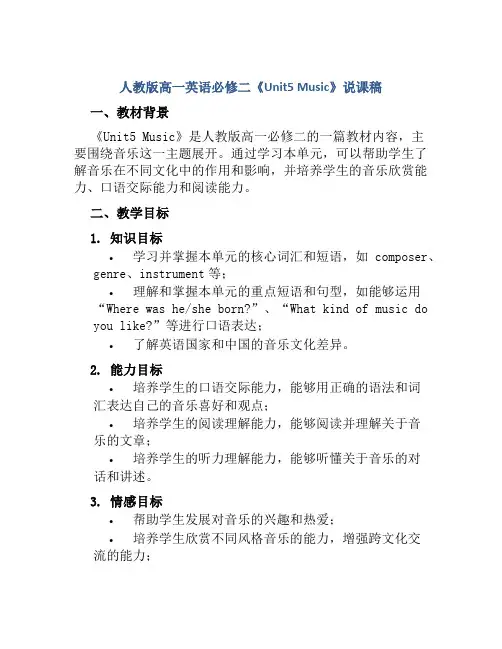
人教版高一英语必修二《Unit5 Music》说课稿一、教材背景《Unit5 Music》是人教版高一必修二的一篇教材内容,主要围绕音乐这一主题展开。
通过学习本单元,可以帮助学生了解音乐在不同文化中的作用和影响,并培养学生的音乐欣赏能力、口语交际能力和阅读能力。
二、教学目标1. 知识目标•学习并掌握本单元的核心词汇和短语,如composer、genre、instrument等;•理解和掌握本单元的重点短语和句型,如能够运用“Where was he/she born?”、“What kind of music do you like?”等进行口语表达;•了解英语国家和中国的音乐文化差异。
2. 能力目标•培养学生的口语交际能力,能够用正确的语法和词汇表达自己的音乐喜好和观点;•培养学生的阅读理解能力,能够阅读并理解关于音乐的文章;•培养学生的听力理解能力,能够听懂关于音乐的对话和讲述。
3. 情感目标•帮助学生发展对音乐的兴趣和热爱;•培养学生欣赏不同风格音乐的能力,增强跨文化交流的能力;•通过学习音乐,培养学生的审美情操和情感表达能力。
三、教学重难点1. 教学重点•理解并掌握本单元的核心词汇和短语;•进行口语表达,用正确的句型和词汇谈论音乐喜好和观点;•阅读和理解关于音乐的文章。
2. 教学难点•帮助学生理解并掌握不同风格音乐的特点和背景;•培养学生批判性思维,提高阅读和分析音乐文章的能力。
四、教学内容与方法1. 教学内容本单元主要包括以下几个部分:•单词学习和词汇拓展:学习与音乐相关的词汇,如composer(作曲家)、genre(风格)、instrument(乐器)等;•语法学习和句型运用:学习问句和回答的句型,如“Where was he/she born?”、“What kind of music do you like?”;•阅读理解:阅读文章《Music Around the World》,了解不同国家的音乐文化差异;•口语表达:谈论音乐喜好、音乐家和音乐风格,学生进行口头交际。
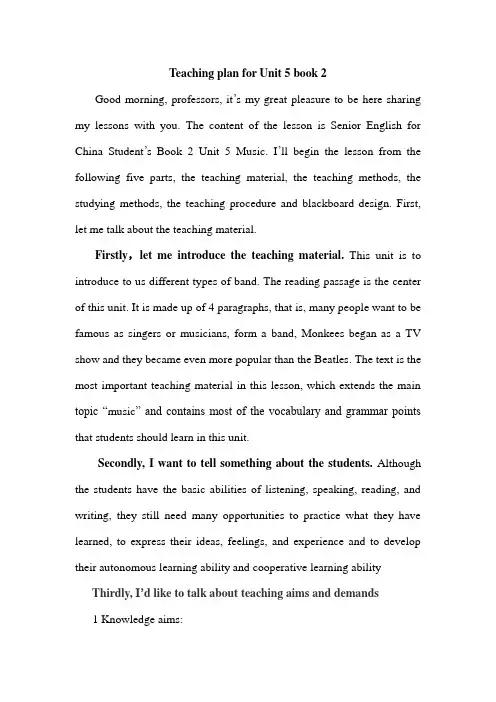
Teaching plan for Unit 5 book 2Good morning, professors, it’s my great pleasure to be here sharing my lessons with you. The content of the lesson is Senior English for China Student’s Book 2 Unit 5 Music. I’ll begin the lesson from the following five parts, the teaching material, the teaching methods, the studying methods, the teaching procedure and blackboard design. First, let me talk about the teaching material.Firstly,let me introduce the teaching material.This unit is to introduce to us different types of band. The reading passage is the center of this unit. It is made up of 4 paragraphs, that is, many people want to be famous as singers or musicians, form a band, Monkees began as a TV show and they became even more popular than the Beatles. The text is the most important teaching material in this lesson, which extends the main topic “music” and contains most of the vocabulary and grammar points that students should learn in this unit.Secondly, I want to tell something about the students. Although the students have the basic abilities of listening, speaking, reading, and writing, they still need many opportunities to practice what they have learned, to express their ideas, feelings, and experience and to develop their autonomous learning ability and cooperative learning ability Thirdly, I’d like to talk about teaching aims and demands1 Knowledge aims:(1)to help students to understand and master the words, phrases and sentence patterns.(2)to know some basic information about music2 Ability aims:(1) To improve the students’ organizing and using skills of English asthe second language(2) To understand the main idea, to scan for the needed informationand to grasp the details3 Emotional aims:(1) Help students understand different type of music and how to forma band(2) Develop students’ sense of cooperative learningFourthly, teaching key points is1. To help the students get a general idea of the whole passage, and some detailed information and language points as well.2. To understand how Monkees formed, developed and succeed. Teaching difficult points is1. The students use their own words to express their own ideas.2. the prep+ whom/which attribute clauseAccording to the analysis above, I’ll try to use the following theories to make students the real master of the class while the teacher myself the director.a. Communicative Language TeachingLanguage is used for communication. It’s learner-centered and emphasizes communication and real-life situations.b. Task-based Language TeachingA task resembles activities which our students or other people carry out in everyday life, Learners should be given opportunities to reflect on what they have learned and how well they are doing.c. Computer Assisted Language TeachingLanguage learning needs a context, which can help the learners to understand the language and then can product comprehensible output, so computer has the advantages to make the materials attractive.Part 3 Learning MethodsTask-based, self-dependent and cooperative learningPart 4 Teaching ProcedureStep One Lead-in“Interest is the best teacher.” Therefore, at the very beginning of the class, I should spark the students’ mind to focus on the centre topic “the band”. I’ll play some different type of music to attract their attention and then bring some questions.Question:What kind of music they like?Which band they know best?The answers must relate to band. After this, the students will be eager to know something about band and this is the very time to naturally lead the class into Step 2Step 2 Reading for information: skimming and scanningIn this step, I use Task-based Language Teaching method, which can give students a clear and specific purpose while skimming and scanning the context.Task 1 General ideaThe students will be asked to just glance at the title and the pictures of the passage, and then guess what they will read in the text. And they’ll be divided into groups of four to have a discussion.The purpose is to inspire the students to read actively, not passively. In addition, the task is to develop the students’ reading skill by making prediction and to encourage the students to express their thoughts in English and cooperate with each other.Task 2 Main idea of each paragraphCooperative learning can raise the students’ interest and create an atmosphere of achievement. Based on this theory, I divide the whole class into 4 groups to skim the whole text and get the main idea of each paragraph.Step 3 Reading for comprehensionThe purpose of reading is to get the correct and useful information. Students should not only have a high speed of reading but also have a correct understanding of details. Therefore the following practices on Page 35 can help check the situation.Step 4 Solving difficult language problems through readingIt’s important for language learners to learn important rules of grammar and use these rules to solve problems in reality. In the previous process of reading, the students must come across some difficult language obstacles, so it’s necessary for us to discuss and explain. This period of time belongs to students. They can ask any questions they come across in the process of learning. I’ll explain the questions and difficulties. The purpose of this is improving the students “questioning spirit” and dealing with the difficulties.Step 5 ConsolidationLanguage is learnt by communicating. It is my job to create an atmosphere for students to use the language. Here I design 2 activities1 Reading for comprehensionI’ll ask 4 students to read each paragraph, and then do the exercise following the text. I think it’s a good way to review what they have learned.2 DiscussionDuring making discussion, the students will deepen their understanding of the main idea of the passage.a. Why Monkees can be successful? Give reasons.b. What’s the most important thing for a successful band? Why? Step 6 HomeworkAsk the students to write down sth about their favorite singers, band or music and list the reasons.The assignment enables the students to search various information resources, which can widen their view and continue to inspire their enthusiasm of learning.Part 5 Blackboard designUnit 4 MusicPassage The Band That Wasn’tTopic Sentences:1. Many people want to be famous as singers or musician2. Form a band3. Began as a TV4. They became even more famous than the BeatlesDiscussion:a. Why Monkees can be successful? Give reasons.b. What’s the most important thing for a successful band? Why?In my opinion, the blackboard des ign can reflect the teacher’s ability of mastering the text and leading the students to master the text easily. In this text, the design is not easy to write. I write the topic sentences on the blackboard, in order to tell the students that this is of the importance in this class. I want to make the design inductive, instructive and artistic.。
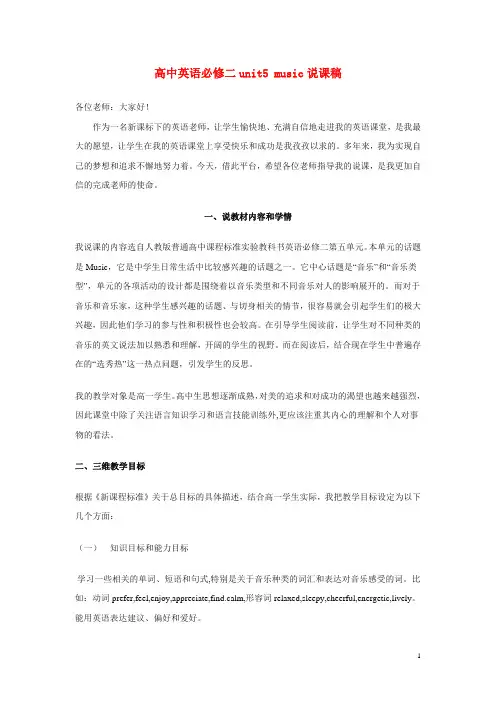
高中英语必修二unit5 music说课稿各位老师:大家好!作为一名新课标下的英语老师,让学生愉快地、充满自信地走进我的英语课堂,是我最大的愿望,让学生在我的英语课堂上享受快乐和成功是我孜孜以求的。
多年来,我为实现自己的梦想和追求不懈地努力着。
今天,借此平台,希望各位老师指导我的说课,是我更加自信的完成老师的使命。
一、说教材内容和学情我说课的内容选自人教版普通高中课程标准实验教科书英语必修二第五单元。
本单元的话题是Music,它是中学生日常生活中比较感兴趣的话题之一。
它中心话题是“音乐”和“音乐类型”,单元的各项活动的设计都是围绕着以音乐类型和不同音乐对人的影响展开的。
而对于音乐和音乐家,这种学生感兴趣的话题、与切身相关的情节,很容易就会引起学生们的极大兴趣,因此他们学习的参与性和积极性也会较高。
在引导学生阅读前,让学生对不同种类的音乐的英文说法加以熟悉和理解,开阔的学生的视野。
而在阅读后,结合现在学生中普遍存在的“选秀热”这一热点问题,引发学生的反思。
我的教学对象是高一学生。
高中生思想逐渐成熟,对美的追求和对成功的渴望也越来越强烈,因此课堂中除了关注语言知识学习和语言技能训练外,更应该注重其内心的理解和个人对事物的看法。
二、三维教学目标根据《新课程标准》关于总目标的具体描述,结合高一学生实际,我把教学目标设定为以下几个方面:(一)知识目标和能力目标学习一些相关的单词、短语和句式,特别是关于音乐种类的词汇和表达对音乐感受的词。
比如:动词prefer,feel,enjoy,appreciate,find.calm,形容词relaxed,sleepy,cheerful,energetic,lively。
能用英语表达建议、偏好和爱好。
学生熟悉掌握不同的音乐类型。
学会灵活运用课文中的句式,自如的表达自己对音乐的理解和感受,并且从更深一层上去把握不同音乐所表达的不同意义。
(二)情感态度1.熟悉各种音乐形式,了解音乐在人们生活中的重要性,提高音乐修养2.从谈论“音乐人的成功”入手使学生了解到做什么事都需要付出艰辛的努力。
人教版高中英语必修第二册 《Unit 5 Music》教案一、教学目标1.知识目标o学生能够掌握与音乐相关的重点词汇和短语,如 “classical, folk, jazz, band, perform” 等。
o学生能够理解并运用描述音乐类型、音乐家和音乐表演的句型。
2.技能目标o学生能够听懂有关音乐话题的对话和短文,获取关键信息。
o学生能够阅读并理解关于音乐的文章,分析作者观点和态度。
o学生能够用英语谈论自己喜欢的音乐和音乐家,并简单介绍音乐对生活的影响。
o学生能够写一篇关于音乐的短文,表达个人对音乐的感受和理解。
3.情感目标o培养学生对音乐的欣赏和热爱,丰富学生的精神世界。
o激发学生通过音乐表达情感和展示个性的意识。
二、教学重难点1.教学重点o重点词汇和短语的掌握及运用。
o对课文中关于音乐知识和情感表达的理解。
o培养学生用英语表达对音乐的喜好和见解的能力。
2.教学难点o如何帮助学生准确运用丰富的词汇和句型描述音乐。
o引导学生深入理解音乐的内涵和价值。
三、教学方法1.视听教学法:通过播放音乐、视频等让学生直观感受音乐的魅力。
2.讨论交流法:组织学生讨论音乐相关话题,促进学生思维碰撞和语言表达。
3.情景创设法:创设音乐场景,让学生在情境中学习和运用语言。
四、教学过程(一)导入(5 分钟)1.播放一段不同类型的音乐片段,如古典音乐、流行音乐、摇滚音乐等。
2.提问学生:What kinds of music do you hear? How do they make you feel?(二)词汇教学(10 分钟)1.展示本单元的重点词汇和短语,结合音乐实例进行讲解。
2.开展词汇游戏,如音乐词汇猜猜猜,加强学生对词汇的记忆和理解。
(三)阅读前准备(5 分钟)1.让学生观察课文标题和图片,预测文章内容。
2.提出一些引导性问题,如:What do you think thepassage will be about music?(四)课文阅读(15 分钟)1.学生快速阅读课文,概括文章的主要内容。
Unit 5 Music The band that wasn’tGood morning, professors, it’s my great pleasure to be here sharing my lessons with you. The content of the lesson is New Senior English for China Student’s Book 2 Unit 5 Music. I’ll begin the lesson from the following six parts,Part 1.Analysis of the teaching materialPart 2.Analysis of the studentsPart 3.The teaching methodsPart 4.The studying methodsPart 5.The teaching procedurePart 6.Backboard designPart 1.Analysis of the teaching materialThe teaching material includes teaching content , teaching aims , teaching key points and teaching difficult points.Teaching contentThis unit is about different kinds of music , and the reading passage plays an important part in this unit . It is about the development of a western popular band called the Monkees and includes many useful words ,expressions and grammar points that students should learn in this unit.Teaching aims1. Knowledge aims:(1)To help students to understand the words and some useful expressions(2)To get the students to know about the development of the western popular band called the Monkees2. Ability aims:(1) To train the students’reading ability by fast reading and careful reading ,and get them to learn more reading skills.(2) To help the students talk about different kinds of music in English.3. Emotional aims:(1) To increase the students’ interest in different kinds of music.(2)To improve the students’ appreciation of music..Teaching key points1. To train the students’ reading ability2. To help the students talk about something about the Monkees in English.Teaching difficult points1. To develop the students’ reading ability2. To help the students grasp the main idea of each paragraph and the whole passage Part 2.Analysis of the studentsOn the one hand ,they’ve learnt English for years, the students have got the basic abilities of listening, speaking, reading, and writing, they still need many opportunities to practice what they have learned, to express their ideas, feelings, and experiences and to develop their self-dependent learning ability and cooperative learning abilityPart 3.The teaching methodsa. Task-based Language Teachingb. Discussionc. Question-and-Answer Method Part 4.The studying methodsa.Self-dependent learning methodb.Cooperative learning methodPart 5.The teaching procedureStep 1 Lead-inI ’ll introduce many different kinds of music and bands to them,then there is also a guessing game of music followed by the questions belowQuestions :1. What kind of music do you like best?2. Which band do you like best?After that ,I ’ll show a picture of the Monkees to lead to step 2Purpose : arouse the students ’ interest of this lesson and attract their attention Step 2 Fast readingIn thos part ,the students will be given two tasks:Task 1 General ideaThe students will be asked to just glance at the title and the pictures of the passage, and then guess what they will read in the text.Task 2 Main idea of each paragraphGet the students to match the main idea with each paragraph Para 1:Para 2:Para 3:Para 4:Match main ideas with paragraphsHow the Monkees formed the band?Dreaming of being famous.How the Monkees became popular and developed as a real band?The common way thatbands form.Methods: self-dependent learning method , Question-and-answer MethodPurpose : To train the students ’ self-depemnent learning ability and have a brief understanding of the passage.Step 3. Careful Reading1. Get the students to read the passage carefully ,and then finish Exercise 1 on page 352. Read and choose the best answers1. What does the title of the passage mean?A.The band wasn’t a famous one.B.The band was formed in a different way.C.The band didn’t play their own music.D.The band wasn’t supported buy his fans.2. How many musicians were there when the band was formed atthe beginning? A. Four B. Three C. Two D. One3. When did the Monkees break up and when did it reunite?A. 1970; 1996B. 1970; 1990C. 1970; the mid-1980sD. 1968; 19864. Which of the following is not correct about “The Monkees”?A. At first, The Monkees copied the style of The Beatles.B.They were not so popular as The Beatles.C.Their performances were really popular and attractive because of their jokes.D.They were copied by other groups and supported by their fans.I’ll divide the students into 2 groups ,and then ask them to finish the tasks by competition and cooperation.If anyone answers the question correctly,his or her group will get 1 point,and the group which get the most points is the winner.Purpose :To train the students to grasp the detailed information and have a better understanding of the text.Through cooperation and competitions,the students get the joy of success which makes the students become more interesed in learning English, at the same time ,it can help the students improve the cooperative learning ability.Step 4 . DiscussionIn order to deepen the students’ understanding of the text ,I will get the students to havea discussion in groups about the following questions:1.What is the Monkees like ?2.Why do you think they can succeed?Methods : discussion, cooperative learning methodPurpose :By doing this ,the students can train their thinking ,speaking and communication abilities , in addition ,I want to get the students to know “No Pain ,No Gain.”Step 5. Summary and homework1.Get the students to retell the story with the help of the information on the blackboard.2.To create your band, write a composition about it with the knowledge you have learnt todayPurpose: By doing this , the students can review the knowledge they have learnt in this lesson ,and train their writing ability.Part 6.blackboard designThe band that wasn’tThe main idea of the textThe main idea of each paragraghDiscussion:1.What is the Monkees like ?2.Why do you think they can succeed?Purpose: to get the students to have a clear idea to get the main content of this lesson.。
unit5music说课稿说课稿——王晓莹我说课的内容是高一英语Book2 Unit 5 Music. Reading The Band That Wasn’t。
这是一节综合技能课。
说课内容包括以下几个部分:教材分析,学情分析,说教法,说学法以及教学程序。
一. 教材分析1. 教学内容:本单元的中心话题是“音乐”。
本文的题目是“The Band That Wasn’t”。
本课是本单元第一课时,在本单元中起启后的作用,为后面知识点的学习、其它课文的理解起很好的铺垫,是本单元的重点。
本课的中心话题是“音乐”和“音乐类型”,主要内容是门基乐队的形成和成长历程。
这种令学生感兴趣的话题、与切身相关的情节很容易使学生情趣盎然,有话可说,同时,也很适合中学生的认知程度,是提升学生阅读能力的很好的素材。
通过本课学习,学生不仅有机会锻炼他们提炼关键语句,进而提升他们阅读水平、分析整合文章的能力;还将对门基乐队有较深的了解,向他们学习可取之处;更为重要的是,学生有机会感受音乐的影响及思考迈向成功的关键所在。
2. 教学目标1)知识目标:注重学生对课文的理解和语言表达,提高学生的阅读能力与技巧。
2)能力目标:围绕这一课题,使学生掌握快速阅读,详细阅读的技巧,能够寻找主题句或归纳总结每段的大意;训练他们捕捉信息,理解信息并整理信息的能力3)德育目标:了解各种各样的音乐形式,深化对音乐的认识,增添音乐欣赏趣味,提高音乐修养;谈论乐队及明星的生活,引导学生用辨证和理智的态度看待明星,树立正确的人生观和价值观。
3.教学重点和难点1)教学重点: ①帮助学生总结归纳段落大意(快速浏览)②分析整理课文中的细节阅读(详细阅读)依据是英语学科新课标要求培养学生综合运用语言的能力,所以我把以上两点做为教学重点,从而起到提纲挈领的效果,便于学生掌握。
2)教学难点:推理并找出门基乐队成功的背后原因。
依据是在教学过程中作为教师必须从自己所教的学生实际情况出发,找出并化解难点以达到预期的教学目的。
高中英语music说课稿尊敬的各位评委、老师们,大家好!今天,我将为大家说课一节高中英语课,主题是“Music”,这是一节结合音乐与英语学习的课程,旨在通过音乐这一跨文化交流的桥梁,提高学生的英语听说能力,同时培养他们对多元文化的认识和欣赏。
首先,我将简要介绍本课的教学目标、教学内容、教学方法和评价方式。
一、教学目标1. 知识目标:学生能够学习并掌握与音乐相关的基本词汇和表达方式。
2. 能力目标:通过听力练习和口语交流,提高学生的英语听说能力。
3. 情感态度与价值观目标:培养学生对音乐的兴趣,增进对不同音乐文化的理解。
二、教学内容1. 热身活动:通过播放不同风格的音乐,引导学生讨论他们喜欢的音乐类型。
2. 词汇学习:介绍与音乐相关的词汇,如genre, rhythm, melody, lyrics等。
3. 听力练习:播放一段关于音乐的英文视频,让学生完成听力理解题。
4. 口语交流:学生分组讨论他们最喜欢的音乐家和歌曲,并用英语进行分享。
5. 写作练习:学生撰写一篇关于音乐的短文,表达自己对音乐的看法和感受。
三、教学方法1. 任务型教学法:通过设计不同的听力、口语和写作任务,激发学生的学习兴趣。
2. 合作学习:鼓励学生分组合作,通过交流和讨论提高英语能力。
3. 多媒体教学:利用音乐、视频等多媒体资源,增加课堂的趣味性和互动性。
四、评价方式1. 过程评价:观察学生在课堂活动中的参与度和合作情况。
2. 作业评价:检查学生的写作作业,评估他们对音乐词汇的掌握和运用能力。
3. 口头报告:通过学生的口语分享,评价他们的英语表达能力和音乐欣赏水平。
接下来,我将具体阐述课堂教学的步骤。
步骤一:热身活动(5分钟)课堂开始,我会播放几段不同风格的音乐,如古典、摇滚、爵士和流行音乐,让学生在轻松愉快的氛围中进入课堂。
随后,我会引导学生讨论他们喜欢的音乐类型,并简要分享原因。
步骤二:词汇学习(10分钟)在热身活动后,我会引入与音乐相关的词汇,通过图片、视频片段和例句,帮助学生理解和记忆。
高中英语必修二《Unit 5 Music》全英文说课稿Good morning professors。
it is a pleasure to be here to share my lesson on r English for China Student's Book 2 Unit 5 Music。
In this lesson。
we will cover the teaching material。
methods。
studying techniques。
teaching res。
and blackboard design。
Let's start with the XXX.The focus of this unit is to introduce different types of bands。
The reading passage is the central component of this unit。
consisting of four paragraphs。
The paragraphs cover topics suchas the desire for XXX musician。
forming a band。
and the success story of the Monkees who XXX than the Beatles。
The text is the most XXX material in this lesson as it expands on the main topicof music and XXX points for students to learn in this unit.Next。
let'XXX.To make the lesson engaging and interactive。
we will use a n of teaching methods。
Teaching plan for Unit 5 book 2Good morning, professors, it’s my great pleasure to be here sharing my lessons with you. The content of the lesson is Senior English for China Student’s Book 2 Unit 5 Music. I’ll begin the lesson from the following five parts, the teaching material, the teaching methods, the studying methods, the teaching procedure and blackboard design. First, let me talk about the teaching material.Firstly,let me introduce the teaching material.This unit is to introduce to us different types of band. The reading passage is the center of this unit. It is made up of 4 paragraphs, that is, many people want to be famous as singers or musicians, form a band, Monkees began as a TV show and they became even more popular than the Beatles. The text is the most important teaching material in this lesson, which extends the main topic “music” and contains most of the vocabulary and grammar points that students should learn in this unit.Secondly, I want to tell something about the students. Although the students have the basic abilities of listening, speaking, reading, and writing, they still need many opportunities to practice what they have learned, to express their ideas, feelings, and experience and to develop their autonomous learning ability and cooperative learning ability Thirdly, I’d like to talk about teaching aims and demands1 Knowledge aims:(1)to help students to understand and master the words, phrases and sentence patterns.(2)to know some basic information about music2 Ability aims:(1) To improve the students’ organizing and using skills of English asthe second language(2) To understand the main idea, to scan for the needed informationand to grasp the details3 Emotional aims:(1) Help students understand different type of music and how to forma band(2) Develop students’ sense of cooperative learningFourthly, teaching key points is1. To help the students get a general idea of the whole passage, and some detailed information and language points as well.2. To understand how Monkees formed, developed and succeed. Teaching difficult points is1. The students use their own words to express their own ideas.2. the prep+ whom/which attribute clauseAccording to the analysis above, I’ll try to use the following theories to make students the real master of the class while the teacher myself the director.a. Communicative Language TeachingLanguage is used for communication. It’s learner-centered and emphasizes communication and real-life situations.b. Task-based Language TeachingA task resembles activities which our students or other people carry out in everyday life, Learners should be given opportunities to reflect on what they have learned and how well they are doing.c. Computer Assisted Language TeachingLanguage learning needs a context, which can help the learners to understand the language and then can product comprehensible output, so computer has the advantages to make the materials attractive.Part 3 Learning MethodsTask-based, self-dependent and cooperative learningPart 4 Teaching ProcedureStep One Lead-in“Interest is the best teacher.” Therefore, at the very beginning of the class, I should spark the students’ mind to focus on the centre topic “the band”. I’ll play some different type of music to attract their attention and then bring some questions.Question:What kind of music they like?Which band they know best?The answers must relate to band. After this, the students will be eager to know something about band and this is the very time to naturally lead the class into Step 2Step 2 Reading for information: skimming and scanningIn this step, I use Task-based Language Teaching method, which can give students a clear and specific purpose while skimming and scanning the context.Task 1 General ideaThe students will be asked to just glance at the title and the pictures of the passage, and then guess what they will read in the text. And they’ll be divided into groups of four to have a discussion.The purpose is to inspire the students to read actively, not passively. In addition, the task is to develop the students’ reading skill by making prediction and to encourage the students to express their thoughts in English and cooperate with each other.Task 2 Main idea of each paragraphCooperative learning can raise the students’ interest and create an atmosphere of achievement. Based on this theory, I divide the whole class into 4 groups to skim the whole text and get the main idea of each paragraph.Step 3 Reading for comprehensionThe purpose of reading is to get the correct and useful information. Students should not only have a high speed of reading but also have a correct understanding of details. Therefore the following practices on Page 35 can help check the situation.Step 4 Solving difficult language problems through readingIt’s important for language learners to learn important rules of grammar and use these rules to solve problems in reality. In the previous process of reading, the students must come across some difficult language obstacles, so it’s necessary for us to discuss and explain. This period of time belongs to students. They can ask any questions they come across in the process of learning. I’ll explain the questions and difficulties. The purpose of this is improving the students “questioning spirit” and dealing with the difficulties.Step 5 ConsolidationLanguage is learnt by communicating. It is my job to create an atmosphere for students to use the language. Here I design 2 activities1 Reading for comprehensionI’ll ask 4 students to read each paragraph, and then do the exercise following the text. I think it’s a good way to review what they have learned.2 DiscussionDuring making discussion, the students will deepen their understanding of the main idea of the passage.a. Why Monkees can be successful? Give reasons.b. What’s the most important thing for a successful band? Why? Step 6 HomeworkAsk the students to write down sth about their favorite singers, band or music and list the reasons.The assignment enables the students to search various information resources, which can widen their view and continue to inspire their enthusiasm of learning.Part 5 Blackboard designUnit 4 MusicPassage The Band That Wasn’tTopic Sentences:1. Many people want to be famous as singers or musician2. Form a band3. Began as a TV4. They became even more famous than the BeatlesDiscussion:a. Why Monkees can be successful? Give reasons.b. What’s the most important thing for a successful band? Why?In my opinion, the blackboard design can reflect the teacher’s ability of mastering the text and leading the students to master the text easily. In this text, the design is not easy to write. I write the topic sentences on the blackboard, in order to tell the students that this is of the importance in this class. I want to make the design inductive, instructive and artistic.。